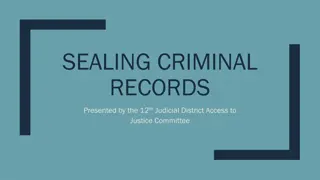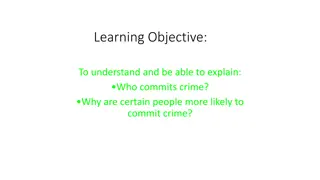Understanding the Criminal Trial Process
The Sixth Amendment guarantees various rights during criminal trials, such as a speedy and public trial, trial by jury, notice of accusations, the right to confront witnesses, and the assistance of counsel. Defendants can opt for a bench trial where the judge decides innocence or guilt. Juries, typically consisting of twelve members, are selected from a pool of potential jurors. The jury selection process aims for impartiality through voir dire examinations. Both prosecution and defense can eliminate biased jurors in most state courts.
Download Presentation

Please find below an Image/Link to download the presentation.
The content on the website is provided AS IS for your information and personal use only. It may not be sold, licensed, or shared on other websites without obtaining consent from the author. Download presentation by click this link. If you encounter any issues during the download, it is possible that the publisher has removed the file from their server.
E N D
Presentation Transcript
Introduction to Criminal Justice Section 5.4: The Trial Prepared by Adam J. McKee 1
Trial Rights The Sixth Amendment has an enormous impact on the criminal trial process. Included among the guarantees are 1. the right to a speedy trial 2. the right to a public trial 3. the right to a trial by jury 4. the right to notice of accusations 5. the right to confront witnesses against the defense 6. the assistance of counsel. 2
Jury Trial v. Bench Trial As with most constitutional rights, the defendant can waive the right to a jury trial and opt to have a bench trial. A bench trial is a type of trial in which the judge serves as the finder of fact and determines the innocence or guilt of the defendant. Such a trial can be advantageous to the defense when the circumstances of the case are likely to cause hostility in a jury such that emotional reactions are likely. 3
The Jury While juries in criminal cases may consist of as few as six members, the most common jury composition in criminal cases is of twelve members. Jurors are selected from a jury pool. The jury pool is formed by selecting (usually randomly) potential jurors from a list created by listing citizens who live within the geographical jurisdiction of the court. 4
Jury Membership Potential jurors are identified in several different ways: Some courts prepare lists from voter registration records, motor vehicle registration records, property tax rolls, and so forth. Members of the jury pool must report for jury duty on a specified date and time. When a case is scheduled for trial, each juror in the pool is assigned a number, and the first slate of potential jurors is randomly selected by number. 5
Jury Selection The Sixth Amendment stipulates that juries must be impartial. In order to eliminate those jurors who might be biased, the court conducts a voir dire examination. Voir Dire is the process of questioning potential jurors and possibly eliminating some of them. 6
Eliminating Jurors In most state courts, both the prosecution and defense may eliminate potential jurors. A challenge for cause can be made if it is demonstrated that the juror is biased in some way. 7
Peremptory Challenge Some jurisdictions allow a certain number of peremptory challenges. A peremptory challenge is the disqualification of a potential juror from jury service where no reason for the challenge is stated. The lawyers are prohibited, however, from excluding anyone from jury duty based on race or gender. This is very difficult to enforce in practice since nearly any reason, no matter how trivial, can be offered to explain why a particular individual was excluded. 8
Elements of a Trial Going forward to a trial is serious business for the defendant. If the prosecution is willing to go that far, then they are convinced that they have a compelling case against the defendant. Statistics show that most criminal defendants that take their case to trial will be found guilty. 9
Opening Statements A criminal trial begins with both sides making statements to the jury. Generally, each side will make statements about what they intend to prove. As a matter of legal custom, the prosecution goes first because it has the burden of proof. The opening statements are not supposed to be argumentative in nature. The idea of the opening statements is to provide a "road map" of the case to the jury. 10
Types of Evidence Facts asserted by both sides in a criminal trial must be supported by evidence. There are several types of evidence: 1. Testimonial evidence consists of statements made by anyone with knowledge of an event. 2. Direct evidence is evidence that tends to prove directly a fact in question. 3. Circumstantial evidence is evidence that creates an inference that a fact exists. 11
Hearsay Hearsay is not generally admissible in court, but there are many exceptions to the hearsay rule. Hearsay is testimony given when the person testifying has no direct knowledge of the facts. In other words, it is second-hand information. One of the most commonly referenced exceptions to the hearsay rule is the dying declaration. 12
Dying Declaration A dying declaration is a statement made by a person that believes that they are about to die. The logic of this exception is that people who are about to die have no reason to lie, and that truthfulness can be safely assumed. 13
Rules of Evidence The procedural rules for the admission of evidence at trial are complex. The courts have heavily regulated what evidence can be presented and how it can be presented in a long history of decisions, as well as rules of evidence. Federal courts abide by the federal rules of evidence, which are a codified version of the rules that developed over hundreds of years from the common law tradition. 14
The Prosecution's Case The next phase of a trial after the prosecution and defense has presented opening statements is the presentation of the state s evidence by the prosecutor. The prosecutor will call witnesses and conduct direct examinations. The defense is permitted to conduct cross-examinations of the witnesses to discredit their testimony. 15
The Confrontation Clause This courtroom testimony is mandatory because the Sixth Amendment guarantees criminal defendants the right to face and question those who give evidence against them. This is often known as the Confrontation Clause. 16
The Defense's Case As a legal matter, there is no requirement that the defense present any evidence: The burden of proof is on the prosecutor. In other words, the defense is under no obligation to prove innocence. All the defense needs to do to prevail is to show that prosecution failed to prove every element of the offense beyond a reasonable doubt. This is no easy task; the beyond the reasonable doubt standard is the highest standard of proof known to American law. 17
The Fifth Amendment Because of the Fifth Amendment protection, the defendant cannot be compelled to testify. Whether or not the defendant does testify is a matter of defense strategy. If the defendant does testify, he or she must face cross-examination. 18
Raising Doubts The most important job of the defense attorney then is the creation of reasonable doubt in the minds of the jurors. This can be done using several strategies. Perhaps the most obvious defense strategy is to present an alibi. Another common strategy is to provide a different account from the prosecution of the evidence that links the defendant to the crime. Another tactic is prosecution s witnesses. to attack the credibility and competence of the 19
Closing Arguments The closing arguments provide each side the opportunity to summarize the evidence presented, and clarify the opposing theories as to what happened. The lawyers are limited to talking about the evidence that has already been presented, and cannot introduce new evidence or refer to evidence that was not presented. 20
Jury Instructions Judges will usually inform the attorneys of his decisions regarding the jury instructions prior to this phase. Knowing what the instructions will be, the attorneys can use the closing argument to relate the instructions to specific pieces of evidence. 21
How Closing Arguments Work In a criminal matter, the prosecution usually will present closing arguments first. The Defense attorney will then give closing arguments for the defense, and will usually speak to the statement made by the prosecutor in the State's closing arguments. In many jurisdictions, the prosecution is allowed a final speech before the jury, known as a rebuttal. 22
Jury Instructions Before the jury leaves the courtroom to deliberate, the judge will give them what are known as jury instructions. These include the elements of the offense charged, how they should apply facts to the law, and defines pertinent legal concepts such as beyond a reasonable doubt. 23
Charge to the Jury Possible verdicts are usually part of the jury instructions. The basic idea is to provide the jury with the relevant law that they should consider in their deliberations. Because the jury instructions must meet certain legal requirements and may be grounds for later appeals, judges often read the instructions to the jury verbatim. This reading of the instructions is known as the judge's charge to the jury. 24
Jury Deliberations After the jury has been charged, the jurors will retire to a jury room for deliberations. The first order of business is to elect a foreperson. The foreperson will preside over the jury deliberations, and deliver the jury's final verdict. Jury deliberations are conducted in secret, and a bailiff will usually be assigned to ensure that no one communicates with the jury during deliberations. 25
Avoiding Outside Influences If the jury does not reach a verdict by the end of the first day of deliberations, it may be sequestered. Sequestration means moving the jurors to a place where they will be secluded and compelled to avoid contact with people and media that might result in the jurors obtaining information about the case. In most cases, the jurors are simply allowed to go home for the night and instructed not to read newspapers, watch news programs, or discuss the case. 26
Unanimous Decisions Most states require that the final verdict reached by a jury in a criminal trial be unanimous. A jury that cannot reach a unanimous verdict is known as a hung jury. If the jury hangs, the judge has no choice but to dismiss the case. If the case is dismissed because of a hung jury, the prosecutor has the option to retry the case in front of a new jury. 27
Double Jeopardy If the jury finds the defendant not guilty, then the same government cannot try the person again for the same charges. This prohibition against trying a person twice for the same offense is known as double jeopardy. The Fifth Amendment prohibition against double jeopardy does not prohibit the person from being sued in civil court, or being charged with the offense by another government entity, such as another state or the federal government. 28
Death Penalty Juries The death penalty is such a serious punishment that those faced with it are given certain extra procedural safeguards. In capital cases, the trial is said to be bifurcated, or split into two parts. The first part of the trial requires the jury to determine guilt or innocence, and the second part of the trial asks jurors to determine if the person deserves to be executed for his (or very rarely her) crimes. In such bifurcated proceedings, the proceedings move to the penalty phase only after a guilty verdict has been reached. 29
The Penalty Phase During circumstances and mitigating circumstances. the penalty phase, the jurors hear about aggravating Aggravating circumstances are things that make the crime more offensive to the public, such as when the victim of a murder is a child or a police officer. Mitigating circumstances are things that make the defendant less culpable for his or her crimes. If the jury cannot unanimously agree on the death penalty, then most jurisdictions have legislation that provides for an automatic life sentence. 30
Jury Nullification As a matter of legal theory, the American system of justice proceeds under the rule of law. In reality, juries can take issue with the substance of the law, the administration of the law, or the sentence imposed by the law. When juries are dissatisfied in this way, they can sometimes disregard the letter of the law and acquit the defendant despite evidence that reaches the level of proof beyond a reasonable doubt. This disregard of the law by jurors is known as jury nullification. 31
Posttrial Process In most jurisdictions, the jury serves as a finder of fact, and are done with their service when a verdict is returned. If that verdict is guilty, the judge most often imposes sentence. Some jurisdictions, however, use a bifurcated trial system where the jury participates in a sentencing phase and chooses the sentence. 32
Posttrial Motions After a guilty verdict is handed down and a sentence is imposed, the defense can still file a few motions. With any guilty verdict, the defense can file a motion for a new trial. If the trial judge sustains this motion, a there will be a new trial, starting from scratch. 33























